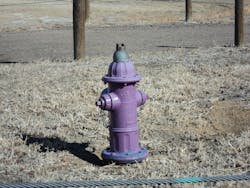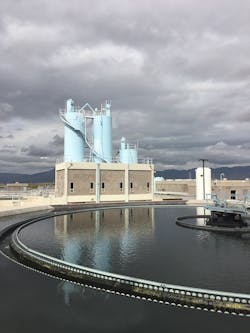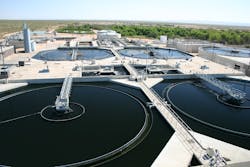Water reuse, the practice of capturing and treating wastewater, stormwater, saltwater, or graywater for some other beneficial purpose, is growing all over. In fact, the volume of recycled water produced in the United States is projected to increase 37 percent, from 4.8 billion gallons per day to 6.6 billion gallons per day by 2027, according to a report by Bluefield Research. The U.S. government has proposed a federal goal of doubling water resource recovery by the year 2030.
The WateReuse Association has touted the value of investment in water reuse for 30 years, and has worked to advance legislative priorities that enable and support the adoption of water recycling across the country. Today, as communities look to bolster their clean water supply, the organization has outlined key legislative priorities to monitor in the coming months and well into the future.
“As we begin the second half of 2020, Congress faces a compressed timeline for completing critical legislation that could include significant investment in water recycling,” Greg Fogel, policy director for the WateReuse Association said. “Part of what we do is try to ensure that those programs are authorized and funded. We also work to create new opportunities to advance reuse through legislation and beat back any legislative efforts that would endanger water recycling [efforts]. At this moment, we’re in the midst of it [all], as Congress is trying to get both authorizing and appropriations legislation done by the end of September.”
In the Senate, two bills — the America’s Water Infrastructure Act of 2020 (AWIA) and the Drinking Water Infrastructure Act of 2020 — propose nearly $20 billion combined in authorizations for key infrastructure projects. Under these bills, the Senate hopes to reauthorize a water reuse program called the Alternative Water Source Grants Program. Administered by U.S. EPA, this grant program would be available nationwide to help communities invest in and implement their own water recycling projects.
“The Senate Environment and Public Works (EPW) Committee has also passed legislation to establish a Federal Inter-Agency Working Group on Water Reuse,” Fogel said, “which would include various departments and agencies across the federal government to coordinate on water recycling activities and try to break down silos and streamline programs [while] leveraging each other’s resources.”
Some of this work is the result of collaboration with EPA and other federal partners to develop the National WateReuse Action Plan (WRAP), Fogel said. Launched in February 2020, the action plan aims to “advance consideration of water reuse and ensure the security, sustainability and resilience of our nation’s water resources,” according to EPA. A total of 37 action items with 200 milestones were outlined by EPA and its partners during the launch.
Action items fall under 11 broad themes or categories, from education and outreach to policy coordination, technology development, international collaborations and more. In July, EPA issued an update on the implementation of WRAP, highlighting several key milestones, including the designation of $15 million in USDA Conservation Innovation Grant funding to support the adoption of innovative conservation approaches on agricultural lands. It marks the first time that water reuse has been included as a priority area within the program.
As both arms of Congress work on FY ‘21 items, the House’s efforts have moved forward more quickly than the Senate’s. In July, the House passed the Water Resources Development Act of 2020 (WRDA), which reauthorizes funding for water projects and policy under the purview of the Army Corps of Engineers. Though water recycling projects are not specifically addressed in the bill, Fogel said he anticipates advocates will work on water recycling issues when the bill moves into conference session, aiming to have something finalized by the end of the year.
One H.R.2 provision of note, introduced by Congressman William James Pascrell (D-N.J.), would remove the cap on private activity bonds for water.
“The private sector [would be able to] engage in public-private partnerships, working with cities and other agencies to implement water projects — including water reuse projects —at basically the same cost of financing that cities have,” Jon Freedman, global government affairs leader for SUEZ’s Water Technologies & Solutions business, said. “That would really spur a lot of public-private partnerships in the water space and cause a huge burst of activity in [water projects] by unleashing all this private sector capital that’s on the sidelines.”
Freedman, who is also Chair of the WateReuse Association’s Legislative and Regulatory Policy Committee, said when it comes to funding for reuse projects, everything is a moving target right now, and while H.R.2 includes a tremendous amount of funding for water projects overall, it’s just a menu of options for the Senate to pick from and agree on which provisions they wish to push forward.
“We have language, but that’s only half the equation,” he said. “Congress still needs to appropriate the money to implement the authorizing legislation.”
Right now, Freedman said it is unclear whether any federal water reuse legislation will be finalized in this calendar year as the nation deals with the ongoing coronavirus pandemic and the upcoming presidential election. It’s a sentiment that is echoed by Fogel, who noted the short time frame in which to get key bills passed this year, on top of appropriations efforts for funds administered by EPA and Bureau of Reclamation, among others.
“One of WateReuse’s top priorities each year is the Title XVI Water Reclamation and Reuse Program, the only federal program uniquely dedicated to water recycling,” Fogel said. “The FY ‘21 Energy and Water Bill provides a whole bunch of money for [Title XVI] legacy projects, while at the same time cuts funding for the competitive grants component of [the program],” Fogel said, noting that his group is working toward increasing funding for competitive grants, which represent the future of the program.
WateReuse is also advocating for increased funding for the clean water SRF and the drinking water SRF programs in the Interior Environment Bill on the EPA side.
While politicians squabble in Washington, public support for water reuse has never been higher. In fact, results of a survey conducted by SUEZ in April showed that more than one-third of respondents would drink recycled water, and nearly half are open to its use for irrigation.
“In general, there’s a lot of interest in helping our nation find a sustainable path forward when it comes to water,” Freedman said. “I just hope that we can move legislation forward sooner rather than later.” WW
About the Author

Alanna Maya
Chief Editor
Alanna Maya is a San Diego State University graduate with more than 15 years of experience writing and editing for national publications. She was Chief Editor for WaterWorld magazine, overseeing editorial, web and video content for the flagship publication of Endeavor's Water Group. In addition, she was responsible for Stormwater magazine and the StormCon conference.



